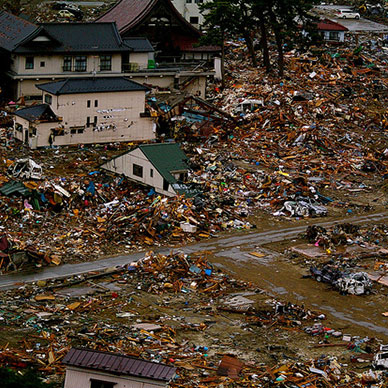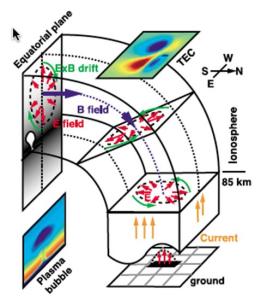
Are Tectonic Pressures Changing the Ionosphere Before Earthquakes?
Original article Quakecasts (http://www.quakecasts.com/?f)
Earlier this year we reported on a growing body of evidence demonstrating that portions of the ionosphere show remarkable and detectable changes in the days and hours before (and after) an earthquake. Of particular importance is the location of these changes: directly over regions where major earthquakes are about to occur. For example, we showed that the ionosphere over coastal Japan showed dramatic anomalies both in its Total Electron Count (TEC) and in the infrared emissions above the epicenter in the days before the massive Tohoku earthquake that killed nearly 20,000 people.
This, of course, comes as no surprise to us here at QuakeCasts, since our earthquake forecasting system is built in large part on identifying those telltale ionospheric changes and alerting our subscribers when the signatures suggest a likely earthquake. But to mainstream seismologists who consistently maintain that earthquakes cannot be predicted, it has been an uphill battle.
Now comes word that Taiwan, which happens to be one of the world’s most seismically active nations, is itself warming to the idea that observations of daytime and nighttime TEC variations within the affected region can be used as precursors for earthquake prediction. In other words, the ionosphere is indeed showing behavioral changes before big earthquakes.
What’s more, however, Taiwan’s Minister of Science, Lou-Chang Lee, believes that the enormous stresses building up along an earthquake fault line may be behind those changes miles above the Earth a theory first proposed by Professor Friedemann Freund here in the United States.
What Are the Rocks Telling Us?
In a recent paper published in the highly regarded Journal of Geophysical Research, senior author Lou-Chang Lee confirms that ionospheric electron counts may anomalously decrease or increase up to 20% before the occurrence of big earthquakes.

Powerful ionization from electrical currents created by tectonic pressures propagate upward, change ionosphere, leading to telltale signatures of earthquakes.
KUO ET AL.: PRE-EARTHQUAKE IONOSPHERIC EFFECT
As we noted in June, that same ionospheric behavior has been detected by other scientists across the globe, most recently NASA Goddard’s Dimitar Ouzounov, who earlier this year made news with his announcement that the ionosphere over Japan changed dramatically in the days before the March 11 magnitude-9.0 earthquake. Coupled with other reports suggesting similar changes over Haiti before its magnitude-7 earthquake in January 2010, it is increasingly clear that something odd is happening in the skies over earthquake epicenters.
What has been far less clear, however, is why those changes are taking place so high above all that terrestrial-based mayhem. For his part, Ouzounov suggests the culprit may be radon gas escaping from the Earth as tectonic plates push and squeeze past each other.
Put simply, Ouzounov and his colleague, Sergey Pulinets of Moscow’s Institute of Applied Geophysics, have put forth a Lithosphere-Atmosphere-Ionosphere Coupling model, which suggests that as tectonic stresses intensify deep in the Earth prior to a major quake, radon and other gases are vented from the Earth’s surface. As the radon propagates up through the atmosphere, a series of complex chemical processes result in changes to the ionosphere’s electron makeup and, by extension, its temperature changes which can be detected by satellite.
But Friedemann Freund of NASA Ames Research Center dismisses radioactive radon for the simple reason that the quantities of radon necessary to produce such changes high above the Earth would prove toxic to most of the terrestrial life where the venting took place an outcome that has yet to be reported either before or after any major earthquakes.
Instead Freund and now Taiwan’s Lee, who cites Freund’s work in his own paper suggests that stressed rocks may themselves be serving as the dynamo behind those ionospheric changes.
Getting Electricity from a Rock
Put as simply as possible, Freund suggests that stressed rocks “particularly at the mammoth scale created by converging tectonic plates“ initiate electric processes in the Earth’s crust, which sometimes generate electrical currents powerful enough to be measured in orbit. Freund characterizes these as
stress-induced positive hole currents.
In a laboratory setting Freund has demonstrated that even a moderate amount of stress applied to one end of a 20-foot slab of granite will produce an electrical current that can be drawn out of the other end. Additionally, Freund and his colleagues showed that as the stress levels are increased, air molecules become massively ionized at the rock’s surface sufficient to produce small sparks off the edges.
Now imagine those same forces at work not on a 20-foot slab of granite but along a 200-mile stretch of crustal plate pressures large enough to rupture the Earth’s crust with a force equivalent to more than two million Hiroshima-type atomic bombs.
For example, even though the fault that ruptured during the monster earthquake in Northern Japan last March was more than 100 kilometers from shore and located beneath thousands of feet of ocean water, the enormous stresses involved must have affected the land mass of the Japanese island as well. Indeed, Freund says the stresses might well have led to a large bubble of highly ionized air, which expanded upward to stratospheric heights and produced a major reaction in the ionosphere 200 – 300km above.
In a kind of chain reaction scenario, those ionospheric earthquake warnings would occur something like this: Enormous tectonic pressures intensify greatly before a major earthquake leading to greater production of electric charges in the Earth’s crust. These currents in turn give rise to massive air ionization propagating up into the atmosphere and wreaking havoc and telltale signatures in the ionosphere.
Indeed, Lee and his team in Taiwan conclude that the magnitude of [electrical] current is the most important parameter to determine TEC variations in the ionosphere. They conclude: We suggest that observations of daytime and nighttime TEC variations and nighttime plasma bubbles within the [earthquake epicenter] can be used as a precursor for earthquake prediction.




